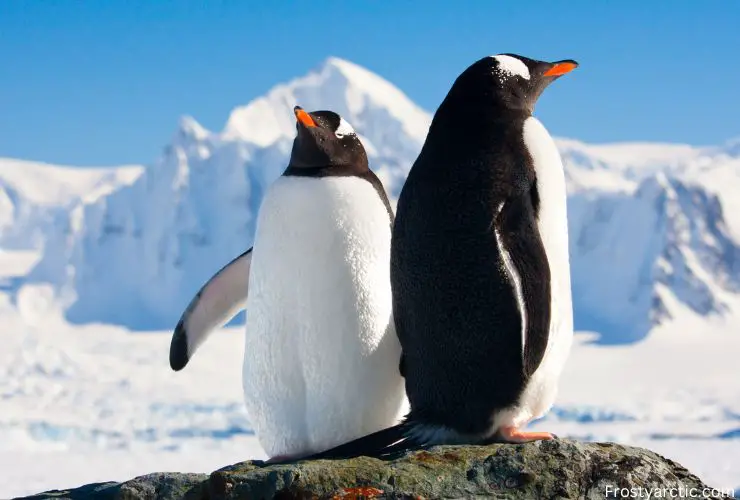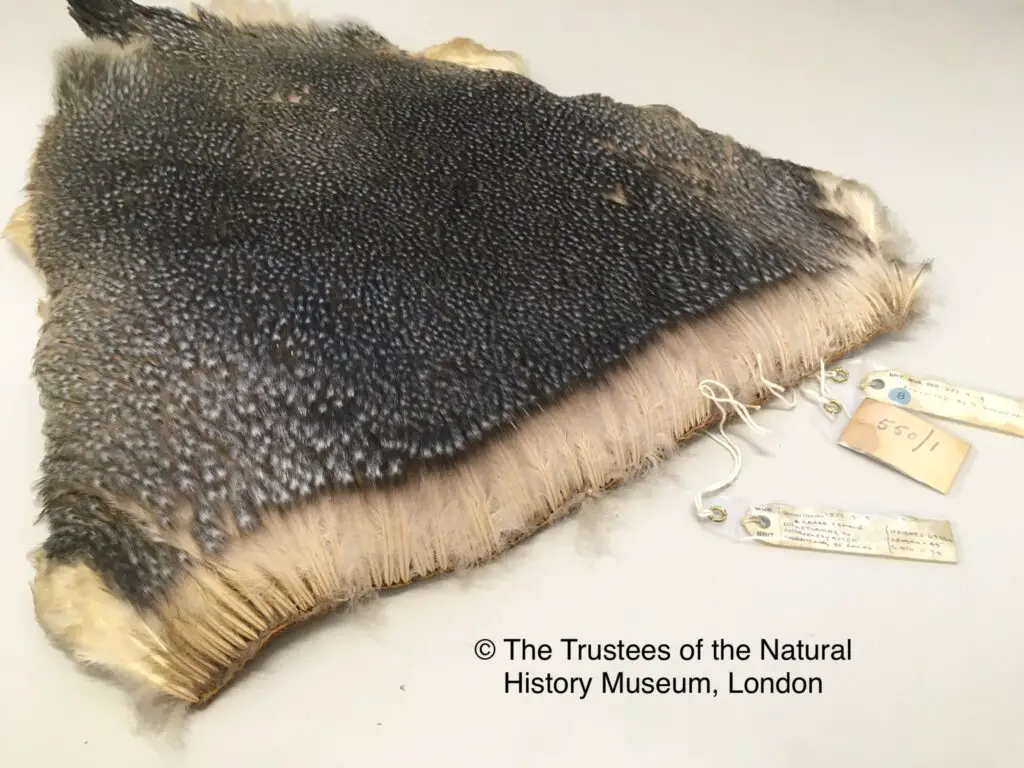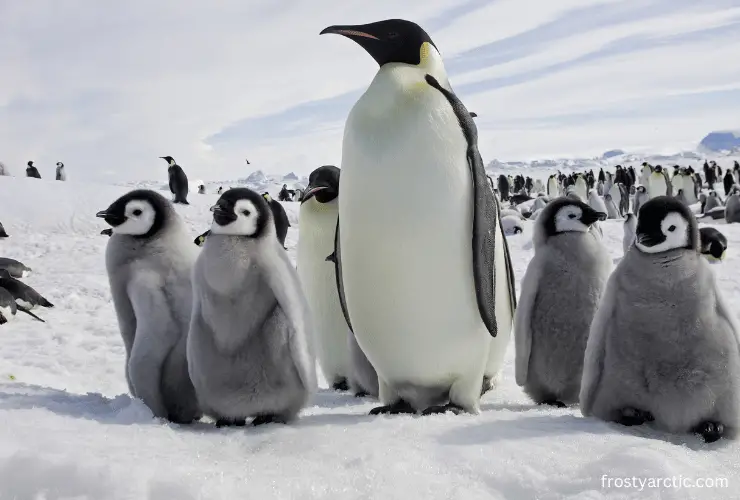Yes, penguins are warm-blooded because their body temperature does not change with variations in the environment’s temperature. Animals with this characteristic are classified as “warm-blooded.” They have a layer of blubber, i.e., fat, under their skin, which keeps them insulated.
Penguins are flightless birds meaning they are warm-blooded animals who can survive the frigid temperatures of the Arctic with ease. Let’s learn more about the characteristics of penguins in this article!
Are Penguins Cold-Blooded or Warm-Blooded?
No, penguins are not cold-blooded. Unlike penguins, cold-blooded animals cannot maintain their body temperature with variations in the environment’s temperature.
On the other hand, penguins can regulate their body temperature regardless of their environment. Thus, they are warm-blooded creatures.
Fun Fact: The internal temperature of a penguin ranges from 37.8°C to 38.9°C (100°F to 102°F.) ~ Seaworld.org
Why Do Penguin Feet Not Freeze?

The temperature of the sea ice in Antarctica can fall below negative 76 degrees Fahrenheit.
Penguins have webbed feet that are not covered with feathers, increasing the surface area exposed to the freezing ice. Consequently, it becomes harder for these animals to maintain a constant body temperature of 40 degrees.
Despite this, their feet do not freeze. The credit goes to the biological adaptations that help them stay warm, even in temperatures negative 76 degrees Fahrenheit.
The complex network of blood vessels in their legs and feet keeps them warm, just above the point of freezing. The constant blood flow also prevents their feet from sticking to the ice.
Penguins have specialized arteries that can help control the blood flow in their legs and feet. The larger the blood flow, the more heat is lost from the body to the environment.
So, when the temperature is low, their blood vessels shrink in diameter to minimize blood flow to their feet. This natural mechanism doesn’t prevent frostbite but also helps minimize heat loss. ~ Penguins.org
How Do Penguins Conserve Heat?
Several biological adaptations help penguins stay warm in their natural habitat. They are as follows:
Overlapping Feathers

The overlapping feathersprovide about 80% to 84% of the thermal insulation for penguins.
This is because of the layer of air that gets trapped between these feathers, preventing wind or water from affecting a penguin’s body temperature.
When penguins dive underwater, this layer is compressed and may dissipate after extended swimming. Thus, penguins rearrange their feathers by preening them.
A layer of Blubber Fat
Penguins have a layer of fat called “blubber” underneath their skin just like whales. This insulates them against the cold, helping them maintain their body temperature on land.
In the sea, however, this fat layer is not enough to shield them against the chilly water.
Did you know? The fat layer of emperor penguins can be 3cm thick, helping them keep warm during the breeding season. ~ Seaworld.org
Black Backs
Penguins are characterized by their black backs and flippers with a contrast of white-colored areas on their bodies. Since black is an excellent absorber of heat, penguins often turn their dark backs to the sun to keep warm.
Flippers
When penguins feel cold, they tuck their flippers close to their bodies to stay warm.
Additionally, the blood flow to penguin flippers is minimal, preventing heat loss from this part of their bodies. ~ Source
Do Penguins Get Cold in Antarctica?
No, penguins do not get cold in Antarctica. These black and white flightless birds take advantage of other behavioral adaptations to stay warm in the Antarctic region.
For instance, penguins tip their feet up to reduce the surface area in contact with the ice. They rest their body weight on their tails and heels to stay warm.
Penguins may also huddle together to keep warm.
Research suggests that about 6,000 male penguins huddle together to incubate eggs during the Antarctic winter. The penguins on the outer edge of the circle continuously move inward, giving each penguin an equal chance of accessing the warmth of the huddle. ~ Seaworld.org
How Do Penguins Survive in Antarctica?

Penguin habitat includes ice, the sea, and the coast. Plus, the frigid temperatures limit food options on land, so they have to resort to the water to prey. Luckily, penguins have several adaptions that help them survive in Antarctica.
For example, penguins have heavy solid bones that help them dive and stay underwater for prolonged periods.
Their flippers help propel them through the water at speeds of about 20 kilometers per hour.
Other adaptations that help them survive include strong legs and webbed feet, streamlining their body to aid in swimming and climbing ice mountains and slopes. Plus, narrow and long bills help them catch prey and defend themselves from predators.
Salt glands located just above the bill between the eyes remove salt from the seawater and fish which the penguins consume. The salt is then removed from their bill.
Penguins are known for their counter-shaded black and white bodies. They have dark backs and white undersides, which provide camouflage, helping them hide from predators when needed.
So, when they are on land, the white underside prevents them from attracting the attention of predators, and when they are at sea, their dark backs prevent them from danger. ~ Yellow Eyed Penguin Trust
FAQs
Are emperor penguins warm-blooded or cold-blooded?
Emperor penguins are warm-blooded animals just like all other penguin species.
How cold can a penguin survive?
Penguins can survive temperatures as low as 70˚C in the center to -20 ˚C around the coast.
How do penguins keep warm by huddling together?
When penguins huddle together, the surface area exposed to the cold is reduced, minimizing heat loss. This helps incubate eggs in the Winter.
Conclusion
Because penguins spend their lives in regions where humans would normally freeze to death, maintaining their body temperature is extremely critical to their survival.
Penguins in colder regions have longer feathers and a thicker fat layer under their skin which keeps them warm.
I hope this article helped clear your confusion about penguins and their warm-blooded nature.



1 thought on “Are Penguins Warm-Blooded? [Secretes of Surviving in Cold]”